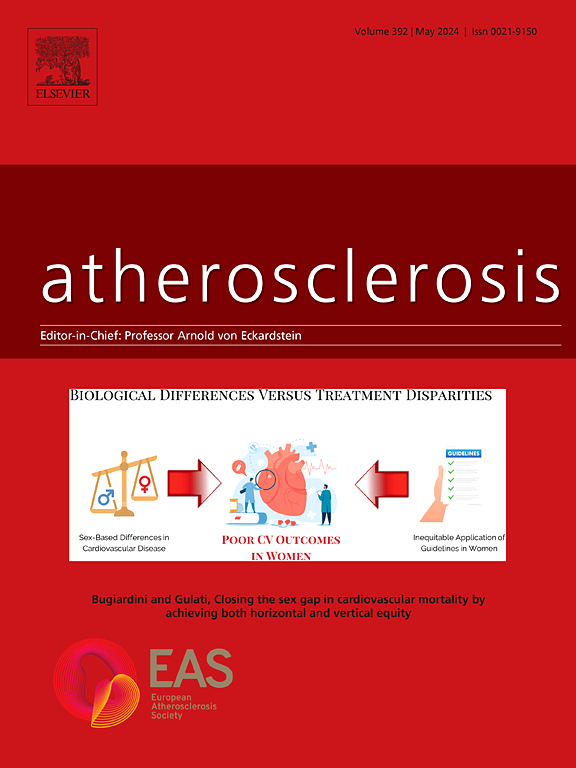Risk of atherosclerosis-related diseases in polymyositis and dermatomyositis patients: A large-scale population-based study
IF 4.9
2区 医学
Q1 CARDIAC & CARDIOVASCULAR SYSTEMS
引用次数: 0
Abstract
Background and aims
Several systemic autoimmune diseases predispose to the enhancement of Atherosclerotic Cardiovascular Disease (ASCVD). These findings underline the role of inflammation in atherogenesis. Dermatomyositis (DM) and polymyositis (PM) are polygenic autoimmune disorders involving mainly skeletal muscles. The association between PM/DM and ASCVD has not been well addressed and explored. We aimed to investigate the association between PM/DM and ASCVD events, we examined the incidence, mortality, and interaction of disease-modifying agents, autoantibodies, and traditional cardiovascular disease (CVD) risk factors in a large population-based sample.
Methods
We conducted a retrospective cohort study using the electronic database of Clalit Health Services (CHS), the largest health organization in Israel. All DM and PM patients diagnosed between 2000 and 2016 were included and matched with healthy controls by age and sex in a 1:5 ratio. Follow-up continued until the first diagnosis of ASCVD or death. The incidence of ASCVD was compared between the groups using univariate and multivariate models adjusting for baseline cardiovascular risk factors.
Results
The study population included 1899 PM/DM patients and 7676 controls. The mean age at the index date was 32.5 years (SD ± 19 years), and the female proportion was 60.3 %, similar for both groups. Traditional cardiovascular risk factors were similar in both groups. The Median follow-up time was 8.4 years (3.6–12.8) in the PM/DM group compared to 8.6 (3.7–12.9) in the control group. 47 (3.0 %) PM/DM patients were diagnosed with ischemic heart disease (IHD) compared to 1.8 % (140) in the controls, yielding a multivariate HR (95%CI) of 1.61 (1.15–2.25). Multivariate HR for cerebrovascular accident (CVA) in the PM/DM group was (95%CI) 2.45 (1.63–3.70). Multivariate HR for ASCVD. (95%CI) was 1.75 (1.35–2.27) in the PM/DM group. APLA-associated antibodies presence was more associated with ASCVD among PM/DM groups than non-ASCVD PM and DM patients (OR 2.33, 95 % CI 1.41–3.86, p < 0.001).
Conclusions
Our study demonstrates that PM and DM are associated with an increased risk of IHD and CVA. Furthermore, PM and DM patients positive for APLA-associated antibodies exhibited excessive rates of ASCVD. These findings support the increased need for awareness and surveillance of cardiological, neuronal, and vascular outcomes in patients suffering from PM/DM.

多发性肌炎和皮肌炎患者动脉粥样硬化相关疾病的风险:一项大规模人群研究
背景和目的:几种全身性自身免疫性疾病易导致动脉粥样硬化性心血管疾病(ASCVD)的加重。这些发现强调了炎症在动脉粥样硬化发生中的作用。皮肌炎(DM)和多发性肌炎(PM)是主要累及骨骼肌的多基因自身免疫性疾病。PM/DM与ASCVD之间的关系尚未得到很好的解决和探讨。我们的目的是研究PM/DM和ASCVD事件之间的关系,我们在一个基于人群的大样本中检查了发病率、死亡率和疾病调节剂、自身抗体和传统心血管疾病(CVD)危险因素的相互作用。方法:我们使用以色列最大的卫生组织Clalit Health Services (CHS)的电子数据库进行了一项回顾性队列研究。纳入2000年至2016年间诊断的所有糖尿病和PM患者,并按年龄和性别按1:5的比例与健康对照者匹配。随访一直持续到首次诊断ASCVD或死亡。采用单变量和多变量模型对基线心血管危险因素进行调整,比较两组间ASCVD的发病率。结果:研究人群包括1899名PM/DM患者和7676名对照组。指标日平均年龄为32.5岁(SD±19岁),女性比例为60.3%,两组差异无统计学意义。两组的传统心血管危险因素相似。PM/DM组的中位随访时间为8.4年(3.6-12.8年),而对照组为8.6年(3.7-12.9年)。47例(3.0%)PM/DM患者被诊断为缺血性心脏病(IHD),而对照组为1.8%(140),多变量风险比(95%CI)为1.61(1.15-2.25)。PM/DM组脑血管意外(CVA)的多变量HR为(95%CI) 2.45(1.63 ~ 3.70)。ASCVD的多变量HR。PM/DM组(95%CI)为1.75(1.35 ~ 2.27)。与非ASCVD的PM和DM患者相比,PM/DM组中apla相关抗体的存在与ASCVD的相关性更大(OR 2.33, 95% CI 1.41-3.86, p)。结论:我们的研究表明PM和DM与IHD和CVA的风险增加相关。此外,apla相关抗体阳性的PM和DM患者表现出过高的ASCVD发生率。这些发现支持对PM/DM患者的心血管、神经和血管结局的认识和监测的增加需求。
本文章由计算机程序翻译,如有差异,请以英文原文为准。
求助全文
约1分钟内获得全文
求助全文
来源期刊

Atherosclerosis
医学-外周血管病
CiteScore
9.80
自引率
3.80%
发文量
1269
审稿时长
36 days
期刊介绍:
Atherosclerosis has an open access mirror journal Atherosclerosis: X, sharing the same aims and scope, editorial team, submission system and rigorous peer review.
Atherosclerosis brings together, from all sources, papers concerned with investigation on atherosclerosis, its risk factors and clinical manifestations. Atherosclerosis covers basic and translational, clinical and population research approaches to arterial and vascular biology and disease, as well as their risk factors including: disturbances of lipid and lipoprotein metabolism, diabetes and hypertension, thrombosis, and inflammation. The Editors are interested in original or review papers dealing with the pathogenesis, environmental, genetic and epigenetic basis, diagnosis or treatment of atherosclerosis and related diseases as well as their risk factors.
 求助内容:
求助内容: 应助结果提醒方式:
应助结果提醒方式:


